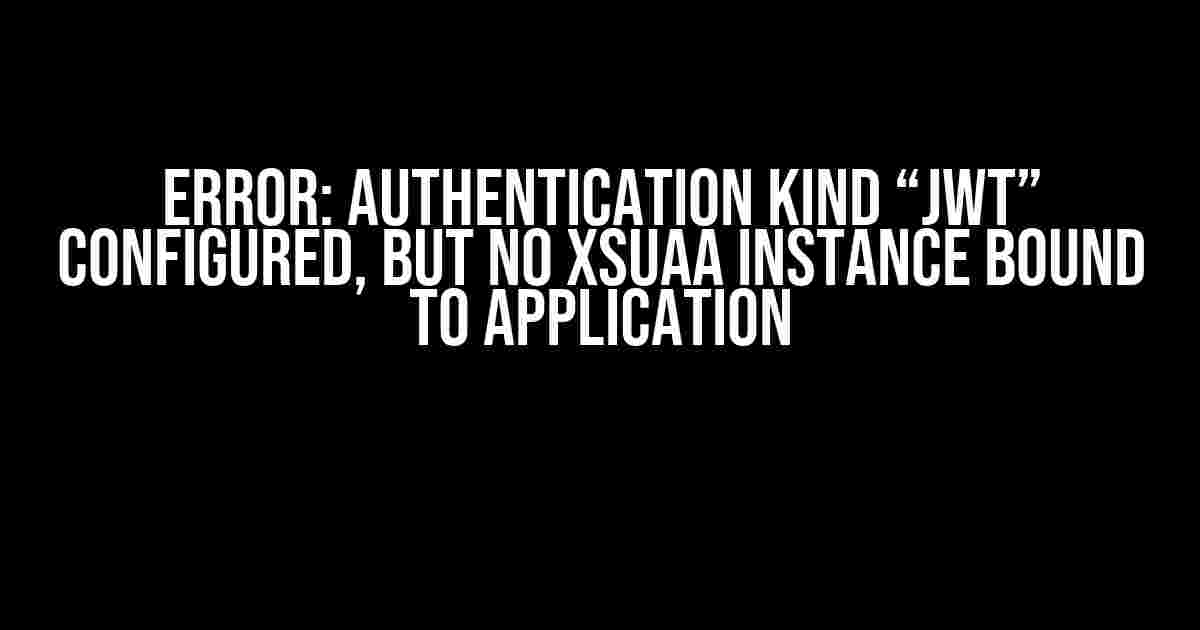If you’re encountering the frustrating error “Error: Authentication kind ‘jwt’ configured, but no XSUAA instance bound to application”, don’t worry, you’re in the right place! In this article, we’ll dive deep into the world of XSUAA and JWT authentication, explaining what this error means, why it occurs, and most importantly, how to fix it.
What is XSUAA?
How does XSUAA work?
- A user requests access to your application.
- Your application redirects the user to the XSUAA service for authentication.
- XSUAA authenticates the user using the chosen authentication method (e.g., username/password, OAuth, or JWT).
- Once authenticated, XSUAA generates a JWT token containing user information and permissions.
- The JWT token is returned to your application, which verifies the token and grants access to the user.
The Error: “Authentication kind ‘jwt’ configured, but no XSUAA instance bound to application”
Why does this error occur?
xsuaaservice instance not created or not bound to the application.- Misconfigured
xsuaaservice instance or JWT authentication settings. - Incorrect or missing environment variables for XSUAA.
- XSUAA service instance not enabled or not properly configured in the SAP Cloud Platform.
How to fix the error?
Step 1: Create an XSUAA service instance
cf create-service xsuaa application xsuaa-instance
Step 2: Bind the XSUAA instance to your application
cf bind-service your-app xsuaa-instance
Step 3: Configure JWT authentication settings
{
"xsuaa": {
"serviceInstances": {
"xsuaa-instance": {
"servicePlan": "application",
"service": "xsuaa"
}
},
"tenantMode": "shared",
"uaa": {
"default": {
"url": "https://uaa.pod-xxxx.xxxxx.sap.hana.ondemand.com"
}
},
"jwt": {
"verify": {
"aud": "your-app-id"
}
}
}
}
Step 4: Set environment variables for XSUAA
| Variable | Value |
|---|---|
| VCAP_SERVICES | XSSUAA service instance credentials |
| xsuaa-instance |
Step 5: Enable XSUAA service instance in SAP Cloud Platform
- Go to your SAP Cloud Platform cockpit.
- Navigate to the “Services” tab.
- Find the XSUAA service instance and click on it.
- Verify that the instance is enabled and configure it according to your needs.
Conclusion
Frequently Asked Question
Stuck with the “Error: Authentication kind "jwt" configured, but no XSUAA instance bound to application” error? Don’t worry, we’ve got you covered!
What does the error “Error: Authentication kind "jwt" configured, but no XSUAA instance bound to application” mean?
This error occurs when your application is configured to use JSON Web Token (JWT) authentication, but it’s not bound to an XSUAA (Extended Services for User Authentication and Authorization) instance. XSUAA is a service provided by SAP Cloud Platform that enables user authentication and authorization.
Why do I need an XSUAA instance bound to my application?
You need an XSUAA instance bound to your application to enable user authentication and authorization using JWT. XSUAA provides a secure way to authenticate users and authorize access to your application. Without an XSUAA instance, your application can’t validate user credentials and ensure secure access.
How do I bind an XSUAA instance to my application?
To bind an XSUAA instance to your application, follow these steps: Go to your SAP Cloud Platform cockpit, navigate to your application, click on “Services” and then click on “Instances”. Create a new XSUAA instance or select an existing one and click “Bind”. Then, go back to your application and configure the XSUAA instance in the “Security” tab.
What are the consequences of not binding an XSUAA instance to my application?
If you don’t bind an XSUAA instance to your application, you won’t be able to use JWT authentication, which can lead to security vulnerabilities and unauthorized access to your application. Additionally, you won’t be able to take advantage of XSUAA’s features, such as user authentication, authorization, and role-based access control.
Can I use other authentication mechanisms instead of JWT and XSUAA?
Yes, you can use other authentication mechanisms, such as OAuth, Basic Auth, or custom authentication mechanisms. However, JWT and XSUAA are the recommended authentication mechanisms for SAP Cloud Platform applications, as they provide a secure and scalable way to authenticate and authorize users.


